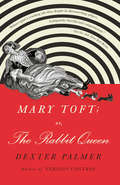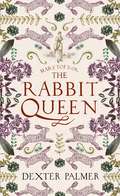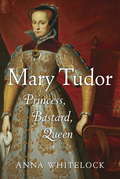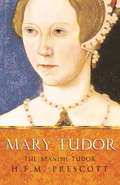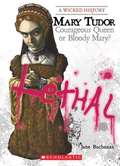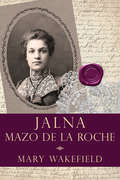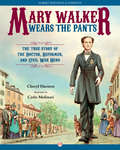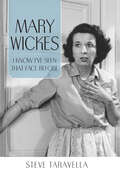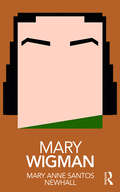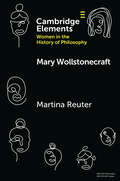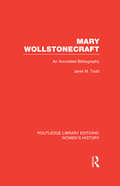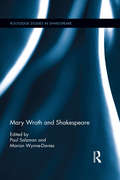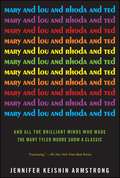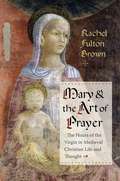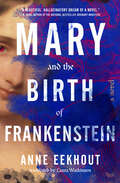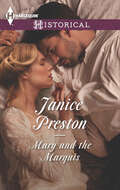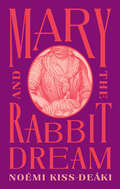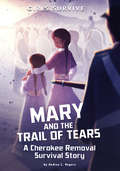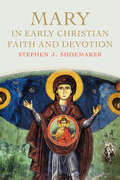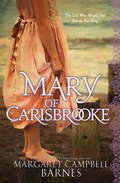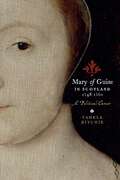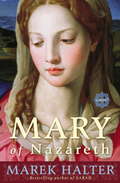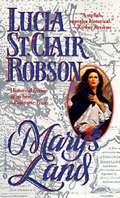- Table View
- List View
Mary Toft; or, The Rabbit Queen: A Novel
by Dexter PalmerIn 1726, in the town of Godalming, England, a woman confounded the nation’s medical community by giving birth to seventeen rabbits. This astonishing true story is the basis for Dexter Palmer’s stunning, powerfully evocative new novel. <P><P>Surgeon’s apprentice Zachary Walsh knows that his master, John Howard, prides himself on his rationality. But John cannot explain how or why Mary Toft, the wife of a local journeyman, has managed to give birth to a dead rabbit. When this singular event becomes a regular occurrence, John and Zachary realize that nothing in their experience as rural physicians has prepared them to deal with a situation like this—strange, troubling, and possibly miraculous. John contacts several of London’s finest surgeons, three of whom soon arrive in Godalming to observe, argue, and perhaps use the case to cultivate their own fame. <P><P>When King George I learns of Mary’s plight, she and her doctors are summoned to London, where Zachary experiences a world far removed from his small-town existence and is exposed to some of the darkest corners of the human soul. All the while Mary lies in bed, as doubts begin to blossom among her caretakers and a growing group of onlookers waits with impatience for another birth, another miracle.
Mary Toft; or, The Rabbit Queen: A Novel
by Dexter Palmer'Palmer spins a cracking tale that, despite its disconcerting subject, is piquantly cheerful and compassionate . . . With empathy and imagination, Palmer explores the master/apprentice relationship, first love and first rivalry, spite and kindness: conjuring a world to raise a wry smile' New York Times---------------------------------------------------------------------------------A stunning, powerfully evocative new novel based on a true story - in 1726 in the small town of Godalming, England, a young woman confounds the medical community by giving birth to dead rabbits.Surgeon John Howard is a rational man. His apprentice Zachary knows John is reluctant to believe anything that purports to exist outside the realm of logic. But even John cannot explain how or why Mary Toft, the wife of a local farmer, manages to give birth to a dead rabbit. When this singular event becomes a regular occurrence, John realizes that nothing in his experience as a village physician has prepared him to deal with a situation as disturbing as this. He writes to several preeminent surgeons in London, three of whom quickly arrive in the small town of Godalming ready to observe and opine. When Mary's plight reaches the attention of King George, Mary and her doctors are summoned to London, where Zachary experiences for the first time a world apart from his small-town existence, and is exposed to some of the darkest corners of the human soul. All the while, Mary lies in bed, waiting for another birth, as doubts begin to blossom among the surgeons and a growing group of onlookers grow impatient for another miracle . . .
Mary Tudor
by Anna WhitelockShe was the first woman to inherit the throne of England, a key player in one of Britain's stormiest eras, and a leader whose unwavering faith and swift retribution earned her the nickname "Bloody Mary." Now, in this impassioned and absorbing debut, historian Anna Whitelock offers a modern perspective on Mary Tudor and sets the record straight once and for all on one of history's most compelling and maligned rulers. Though often overshadowed by her long-reigning sister, Elizabeth I, Mary lived a life full of defiance, despair, and triumph. Born the daughter of the notorious King Henry VIII and the Spanish Katherine of Aragon, young Mary was a princess in every sense of the word--schooled in regal customs, educated by the best scholars, coveted by European royalty, and betrothed before she had reached the age of three. Yet in a decade's time, in the wake of King Henry's break with the pope, she was declared a bastard, disinherited, and demoted from "princess" to "lady." Ever her deeply devout mother's daughter, Mary refused to accept her new status or to recognize Henry's new wife, Anne Boleyn, as queen. The fallout with her father and his counselors nearly destroyed the teenage Mary, who faced imprisonment and even death. It would be an outright battle for Mary to work herself back into the king's favor, claim her rightful place in the Tudor line, and ultimately become queen of England, but her coronation would not end her struggles. She flouted the opposition and married Philip of Spain, sought to restore Catholicism to the nation, and fiercely punished the resistance. But beneath her brave and regal exterior was a dependent woman prone to anxiety, whose private traumas of phantom pregnancies, debilitating illnesses, and unrequited love played out in the public glare of the fickle court. Anna Whitelock, an acclaimed young British historian, chronicles this unique woman's life from her beginnings as a heralded princess to her rivalry with her sister to her ascent as ruler. In brilliant detail, Whitelock reveals that Mary Tudor was not the weak-willed failure as so often rendered by traditional narratives but a complex figure of immense courage, determination, and humanity.
Mary Tudor (Women In History Ser.)
by H.F.M. PrescottA highly-readable popular biography of 'Bloody Mary' - winner of the James Tait Black prize.Mary I is notorious for her persecution of Protestants and has been vilified by generations of partisan historians. H.F.M. Prescott brings a more humane and measured perspective to the life of this tormented woman. First published in 1940 under the title SPANISH TUDOR, Prescott's biography won the James Tait Black prize the following year. An extensively revised and updated edition was published in 1953 under the title MARY TUDOR.Prescott sums up her subject's life as follows: 'Perhaps no other reign in English history has seen such a great endeavour made, and so utterly defeated. All that Mary did was undone, all she intended utterly unfulfilled...mistaken often, almost always misguided in her public office, with much blindness, some rancour, some jealousy, some stupid cruelty to answer for, she had yet trodden, lifelong and manfully, the way that other sinners know.'
Mary Tudor: Courageous Queen or Bloody Mary?
by Jane BuchananBiography of Mary Tudor, Queen of England
Mary Wakefield
by Mazo De La RocheFirst published in 1949, in Mary Wakefield, the third book in the Jalna series, a young English woman is hired by Ernest Whiteoak to be a governess to Philip’s motherless children. When Philip falls in love with her, his mother does all she can to prevent the marriage. This is book 3 of 16 in The Whiteoak Chronicles. It is followed by Young Renny.
Mary Walker Wears the Pants
by Cheryl Harness Carlo MolinariThe story of Mary Edwards Walker, the doctor and women's rights activist who served in the Civil War and received the Medal of Honor. Mary Edwards Walker was unconventional for her time: She was one of the first women doctors in the country, she was a suffragist, and she wore pants! And when the Civil War struck, she took to the battlefields in a modified Union uniform as a commissioned doctor. For her service, she became the only woman ever to earn the Medal of Honor. This picture book biography tells the story of a remarkable woman who challenged traditional roles and lived life on her own terms. This is a fixed-format ebook, which preserves the design and layout of the original print book.
Mary Wickes: I Know I've Seen That Face Before (Hollywood Legends Series)
by Steve TaravellaMoviegoers know her as the housekeeper in White Christmas, the nurse in Now, Voyager, and the crotchety choir director in Sister Act. This book, filled with never-published behind-the-scenes stories from Broadway and Hollywood, chronicles the life of a complicated woman who brought an assortment of unforgettable nurses, nuns, and housekeepers to life on screen and stage. Wickes (1910–1995) was part of some of the most significant moments in film, television, theatre, and radio history. On that frightening night in 1938 when Orson Welles recorded his earth-shattering “War of the Worlds” radio broadcast, Wickes was waiting on another soundstage for him for a rehearsal of Danton's Death, oblivious to the havoc taking place outside. When silent film star Gloria Swanson decided to host a live talk show on this new thing called television, Wickes was one of her first guests. When Lucille Ball made one of her first TV appearances, Wickes appeared with her—and became Lucy's closest friend for more than thirty years. Wickes was the original Mary Poppins, long before an umbrella carried Julie Andrews across the rooftops of London. And when Disney began creating 101 Dalmatians, Wickes was asked to pose for animators trying to capture the evil of Cruella De Vil. The pinched-face actress who cracked wise by day became a confidante to some of the day's biggest stars by night, including Bette Davis and Doris Day. Bolstered by interviews with almost three hundred people, and by private correspondence from Ball, Davis, Day, and others, Mary Wickes: I Know I've Seen That Face Before includes scores of never-before-shared anecdotes about Hollywood and Broadway. In the process, it introduces readers to a complex woman who sustained a remarkable career for sixty years.
Mary Wigman: Modernity And Mary Wigman, 1886--1973 (Routledge Performance Practitioners)
by Mary Anne Santos NewhallThis book considers dancer, teacher, and choreographer Mary Wigman, a leading innovator in Expressionist dance whose radical explorations of movement and dance theory are credited with expanding the scope of dance as a theatrical art. Now reissued, this book combines: a full account of Wigman’s life and work an analysis of her key ideas detailed discussion of her aesthetic theories, including the use of space as an "invisible partner" and the transcendent nature of performance a commentary on her key works, including Hexentanz and The Seven Dances of Life an extensive collection of practical exercises designed to provide an understanding of Wigman’s choreographic principles and her uniquely immersive approach to dance. As a first step towards critical understanding, and as an initial exploration before going on to further, primary research, Routledge Performance Practitioners are unbeatable value for today’s student.
Mary Wollstonecraft (Elements on Women in the History of Philosophy)
by Martina ReuterMary Wollstonecraft is recognized as an important early feminist. This Element argues that she is also an ingenious moral philosopher, who showed that true virtue and the liberty of women are necessarily interdependent. The Element consists of eight sections. After an introduction, Section 2 discusses Wollstonecraft's concept of reason by examining its metaphysical foundation and its role as moral capacity. According to Wollstonecraft, reason interacts closely with the passions. Then, Sections 3 and 4 discuss the roles of the passions and the imagination. Reason, passion and imagination all come together in Wollstonecraft's discussions of love and friendship, which are the topic of Section 5. Wollstonecraft values education and knowledge, but discussions of her epistemology have been rare. Section 6 analyses some aspects of her views on knowledge. Finally, Section 7 discusses Wollstonecraft's notion of virtue, including its relations to liberty and duty. Section 8 makes some general conclusions.
Mary Wollstonecraft: An Annotated Bibliography (Routledge Library Editions: Women's History #No. 381)
by Janet ToddFirst published in 1976, this was the first comprehensive annotated bibliography of Mary Wollstonecraft’s works and most of the critical and biographical comments on her in English written between 1788 and 1975. It is designed both as a research tool for scholars and students and as a revelation of the quantity and variety of comment. The book is divided into three main chronological time periods of publication date and suggests the vagaries of Wollstonecraft’s posthumous reputation and indicates the peaks and troughs of interest. Known as an eighteenth-century British writer, philosopher, and advocate of women's rights, Mary Wollstonecraft has received much critical attention with particular interest in her unorthodox lifestyle of the time and is now regarded as one of the founding feminist philosophers.
Mary Wroth and Shakespeare (Routledge Studies in Shakespeare)
by Paul Salzman Marion Wynne-DaviesOver the last twenty five years, scholarship on Early Modern women writers has produced editions and criticisms, both on various groups and individual authors. The work on Mary Wroth has been particularly impressive at integrating her poetry, prose and drama into the canon. This in turn has led to comparative studies that link Wroth to a number of male and female writers, including of course, William Shakespeare. At the same time no single volume has attempted a comprehensive comparative analysis. This book sets out to explore the ways in which Wroth negotiated the discourses that are embedded in the Shakespearean canon in order to develop an understanding of her oeuvre based, not on influence and imitation, but on difference, originality and innovation.
Mary and Lou and Rhoda and Ted
by Jennifer Keishin ArmstrongThe story of the making of a classic and groundbreaking TV show, as experienced by its producers, writers, and cast. Mary Tyler Moore made her name as Dick Van Dyke's wife on the eponymous show, a cute, unassuming housewife that audiences loved. But when her writer/producers James Brooks and Allan Burnes dreamed up an edgy show about a divorced woman with a career, network executives replied: "Americans won't watch television about New York City, divorcees, men with mustaches, or Jews." But Moore and her team were committed, and when the show finally aired, in spite of tepid reviews, fans loved it. Jennifer Armstrong introduces readers to the show's creators; its principled producer, Grant Tinker; and the writers and actors who attracted millions of viewers. As the first situation comedy to employ numerous women as writers and producers, The Mary Tyler Moore Show became a guiding light for women in the 1970s. The show also became the centerpiece of one of greatest evenings of comedy in television history, and Jennifer Armstrong describes how the television industry evolved during these golden years.
Mary and the Art of Prayer: The Hours of the Virgin in Medieval Christian Life and Thought
by Rachel Fulton BrownWould you like to learn to pray like a medieval Christian? In Mary and the Art of Prayer, Rachel Fulton Brown traces the history of the medieval practice of praising Mary through the complex of prayers known as the Hours of the Virgin. More than just a work of comprehensive historical scholarship, the book asks readers to immerse themselves in the experience of believing in and praying to Mary. Mary and the Art of Prayer crosses the boundaries that modern scholars typically place between observation and experience, between the world of provable facts and the world of imagination, suggesting what it would have been like for medieval Christians to encounter Mary in prayer.Mary and the Art of Prayer opens with a history of the devotion of the Hours or “Little Office” of the Virgin. It then guides readers in the practice of saying this Office, including its invitatory (Ave Maria), antiphons, psalms, lessons, and prayers. The book works on several levels at once. It provides a new methodology for thinking about devotion and prayer; a new appreciation of the scope of and audience for the Hours of the Virgin; a new understanding of how Mary functions theologically and devotionally; and a new reading of sources not previously taken into account. A courageous and moving work, it will transform our ideas of what scholarship is and what it can accomplish.
Mary and the Birth of Frankenstein: A Novel
by Anne Eekhout“A beautiful, hallucinatory dream of a novel.” –J.M. Miro, Author of the National Bestseller Ordinary Monsters“A fantastically moody, unsettling novel, with a teasing, enigmatic atmosphere entirely its own."–Sarah Waters, New York Times bestselling author of The Paying Guests and FingersmithAn intensely gripping reimagining of Mary Shelley’s youth, vividly exploring innocence, young love, gothic mystery and the roots of her literary masterpiece, Frankenstein.Switzerland, 1816. A volcanic eruption in Indonesia envelopes the whole of Europe in ash and cloud. Amid this “year without a summer,” eighteen-year-old Mary Shelley and her lover Percy Bysshe Shelley arrive at Lake Geneva to visit Lord Byron and his companion John Polidori. Anguished by the recent loss of her child, Mary spends her days in strife. But come nightfall, the friends while away rainy wine-soaked evenings gathered around the fireplace, exchanging stories. One famous evening, Byron issues a challenge to write the best ghost story. Contemplating what to write, Mary recalls another summer, when she was fourteen…Scotland, 1812. A guest of the Baxter family, Mary arrives in Dundee, befriending young Isabella Baxter. The girls soon spend hours together wandering through fields and forests, concocting tales about mythical Scottish creatures, ghosts and monsters roaming the lowlands. As their bond deepens, Mary and Isabella’s feelings for each other intensify. But someone has been watching them—the charismatic and vaguely sinister Mr. Booth, Isabella's older brother-in-law, who may not be as benevolent as he purports to be…With gripping mastery and verve, Anne Eekhout brings to life a defining moment in Mary Shelley’s youth: the creative wellspring for one of the most original, thrilling, and timeless pieces of literature ever written. Provocative, wonderfully atmospheric and pulsing with emotion, Mary and the Birth of Frankenstein is a hypnotic ode to the power of imagination.Translated from the Dutch by Laura Watkinson
Mary and the Marquis
by Janice PrestonCURED WITH A KISS... When destitute widow Mary Vale aids an injured man on the road, she is shocked to discover that he is the reclusive Lucas Alastair, Marquis of Rothley! She's intrigued by the dark marquis, but when she offers to nurse him back to health in return for shelter, he proves a difficult patient! Lucas hides some deep emotion beneath his brusque manner, and a stolen kiss leaves her longing for more.... Able to help mend his physical injuries, can Mary heal the wounds of his painful past?
Mary and the Rabbit Dream
by Noémi Kiss-DeákiA sardonic, feminist reimagining of the story of Mary Toft, infamous rabbit-birthing hoaxer.Mary Toft was just another eighteenth-century woman living in poverty, misery, and frequent pain. The kind of person overlooked by those with power, forgotten by historians. Mary Toft was nothing. Until, that is, Mary Toft started giving birth to rabbits… Sensational debut novelist Noémi Kiss-Deáki reimagines Mary’s strange and fascinating story – and how she found fame when a large swath of England became convinced that she was the mother of rabbits. Mary and the Rabbit Dream is a story of bodily autonomy, of absurdity, of the horrors inflicted on women, of the cruel realities of poverty, and the grotesque divides between rich and poor. A story told with exquisite wit, skill, and a beautiful streak of subversive mischief."Noémi Kiss-Deáki's style is astonishing – hypnotic, poetic, persistent, wild, blazing and marvellous. As the novel unfolds you simply can't believe what is happening – it's outrageous, it's cruel, it's unfathomable and yet – it's the way of the world. Here is Mary Toft's tale, retold in dazzling prose that is both exquisite and furious. Noémi reimagines the possibilities for historical fiction and Mary and the Rabbit Dream is utterly original and utterly brilliant." – Victoria MacKenzie, author of For Thy Great Pain Have Mercy On My Little Pain“One of those novels that seemingly arrives from nowhere, fully formed, as odd, disturbing, and lingering as the most vivid of fever dreams. To create something so playfully provocative, subversive and gripping displays a rare literary talent. I’ve never read anything like it.” – Benjamin Myers, author of The Gallows Pole“In Mary and the Rabbit Dream, Noémi Kiss-Deáki transforms the tale of Mary Toft into a stinging, witty critique of the oppressions heaped upon the bodies of impoverished women. This is a brave debut, one told with courage and wit, one which dissects a ruthless system of class and gender – and lays bare the concentric circles of power that still govern our world.” – Selby Wynn Schwartz, author of After Sappho“I loved Mary and the Rabbit Dream – a sprightly but savage tale that re-imagines the real-life case of Mary Toft, who, in 1726, supposedly started giving birth to rabbits … It’s a supple, smartly self-conscious and ingenious take on the historical novel.” – Lucy Scholes, editor of A Different Sound: Stories by Mid-Century Women Writers“A tense, nightmarish book about power and incarnation. … Stylish, visceral, incandescent.” – Clare Pollard, author of Delphi“Mary and the Rabbit Dream casts the curious early-eighteenth-century story of Mary Toft in a totally fresh light. This is a furious, vituperative story about class, poverty, violence, and women’s bodies.” – Stu Hennigan, author of Ghost Signs
Mary and the Trail of Tears: A Cherokee Removal Survival Story (Girls Survive)
by Andrea L. RogersTwelve-year-old Mary and her Cherokee family are forced out of their home in Georgia by U.S. soldiers in May 1838. From the beginning of the forced move, Mary and her family are separated from her father. Facing horrors such as internment, violence, disease, and harsh weather, Mary perseveres and helps keep her family and friends together until they can reach the new Cherokee nation in Indian Territory. Featuring nonfiction support material, a glossary, and reader response questions, this Girls Survive story explores the tragedy of forced removals following the Indian Removal Act of 1830.
Mary in Early Christian Faith and Devotion
by Stephen J. ShoemakerFor the first time a noted historian of Christianity explores the full story of the emergence and development of the Marian cult in the early Christian centuries. The means by which Mary, mother of Jesus, came to prominence have long remained strangely overlooked despite, or perhaps because of, her centrality in Christian devotion. Gathering together fresh information from often neglected sources, including early liturgical texts and Dormition and Assumption apocrypha, Stephen Shoemaker reveals that Marian devotion played a far more vital role in the development of early Christian belief and practice than has been previously recognized, finding evidence that dates back to the latter half of the second century. Through extensive research, the author is able to provide a fascinating background to the hitherto inexplicable "explosion" of Marian devotion that historians and theologians have pondered for decades, offering a wide-ranging study that challenges many conventional beliefs surrounding the subject of Mary, Mother of God.
Mary of Carisbrooke
by Margaret Campbell BarnesThe moving, tragic story of Charles I, the last absolute monarch of England, during his imprisonment in Carisbrooke Castle on the Isle of Wight. Richly drawn and inspired by the New York Times bestselling author's own experience living on the Isle of Wight, this dramatic retelling brings to life the cavalier king whom Cromwell deposed. But even more fascinating than the account of royal hopes and misfortunes is the tale of a charming servant girl who is as romantic and tender in love as she is bold and resourceful in plotting the king's escape.
Mary of Guise in Scotland, 1548–1560: A Political Career
by Pamela E. RitchieChallenging the conventional interpretation of Mary of Guise as the defender of Catholicism whose regime climaxed with the Reformation Rebellion, Pamela Ritchie shows that Mary was, on the contrary, a shrewd and effective politique, whose own dynastic interests and those of her daughter took precedence over her personal and religious convictions. Dynasticism, not Catholicism, was the prime motive force behind her policy. Mary of Guise’s dynasticism, and political career as a whole, were inextricably associated with those of Mary Queen of Scots, whose Scottish sovereignty, Catholic claim to the English throne and betrothal to the Dauphin of France carried with them notions of Franco-British Imperialism. Mary of Guise's policy in Scotland was dictated by European dynastic politics and, specifically, by the Franco-Scottish alliance of 1548–1560. Significantly more than a betrothal contract, the Treaty of Haddington established a ‘protectoral’ relationship between the ‘auld allies’ whereby Henri II was able to assume control over Scottish military affairs, diplomacy and foreign policy as the ‘protector’ of Scotland. Mary of Guise’s assumption of the regency in 1554 completed the process of establishing French power in Scotland, which was later consolidated, albeit briefly, by the marriage of Mary Stewart to Francois Valois in 1558. International considerations undermined her policies and weakened her administration, but only with her death did Mary of Guise’s regime and French power in Scotland truly collapse.
Mary of Nazareth
by Marek HalterThe ancient world through the eyes of a young Jewish woman—Mary of Nazareth. Mary was born into a Palestine oppressed by Herod the Great; she is accustomed to living with uncertainty and unrest. But when her beloved father is wrongly imprisoned by the Romans, she takes action. She calls upon a well-known rebel by the name of Barabbas, and together they set out to save her father. A daring escape is planned. And against staggering odds, Mary’s father is saved from crucifixion. Barabbas—flush with his success—is intent on leading a full-scale rebellion against Herod and the Romans. But as he speaks before Jewish leaders, Mary feels great frustration as the men endlessly debate morality, rebellion, and God's will. She has almost lost her father, but she is nevertheless compelled to speak out against violence. To her surprise, one man listens: Joseph. He makes Mary an offer that will change her life—and the history of the Jewish people—forever.
Mary's Land
by Lucia St. Clair RobsonAs the ship Charity sails from England across the Atlantic, two vastly different yet equally courageous women make the perilous journey. Strong-willed, upper class Margaret Brent has invested in Lord Baltimore's Maryland plantation because the new colony is her single chance for a home of her own. Anicah is a teenage guttersnipe who lives by her wits and quick tongue. Kidnapped off the streets of Bristol, she is transported to the New World as an indentured servant. But for both women, the future will bring love and rewards they never imagined.
Mary's Mosaic: The CIA Conspiracy to Murder John F. Kennedy, Mary Pinchot Meyer, and Their Vision for World Peace: Third Edition
by Dick Russell Peter JanneyExplores the murder of Mary Pinchot Meyer and her connected to President KennedyIdeal book for fans of The Devil’s Chessboard by David Talbot, The Reporter Who Knew Too Much by Dorothy Kilgallen, Dr. Mary’s Monkey by Edward T. Haslam, and other JFK conspiracy booksUpdated edition of the true crime expose, including new evidence and government documents corroborating the conspiracy to assassinate JFK’s trusted ally and final true loveThe death of Mary Meyer left many Americans with questions. Who really killed her? Why did CIA counterintelligence chief James Angleton rush to find and confiscate her diary? Had she discovered the plan to assassinate her lover, President Kennedy, with the trail of information ending at the steps of the CIA? Was it only coincidence that she was killed less than three weeks after the release of the Warren Commission Report?Fans of The Murder of Mary Russell, JFK: A Vision for America, and other JFK books will love Mary’s Mosaic. Building and relying on years of interviews and painstaking research, author Peter Janney follows the key events and influences in Mary Pinchot Meyer’s life—her first meeting with Jack Kennedy; her support of her secret lover, President Kennedy, as he worked towards the pursuit of world peace and away from the Cold War; and her exploration of psychedelic drugs. Fifty years after the assassinations of President Kennedy and Mary Meyer, this book helps readers understand why both took place. Author Peter Janney fought for two years to obtain documents from the National Personnel Records Center and the US Army to complete this third edition. It includes a final chapter about the mystery man who could be the missing piece to learn the truth behind Meyer’s murder.
Mary's Place: A Novel
by Charlotte HingerSet against the backdrop of the farm crisis of the 1980s, Charlotte Hinger&’s moving novel explores the lives of Mary and Iron Barrett as they face the multiple calamities imposed by overproduction, debt, falling commodity prices, rural bank restructuring, and internal family dysfunction.
